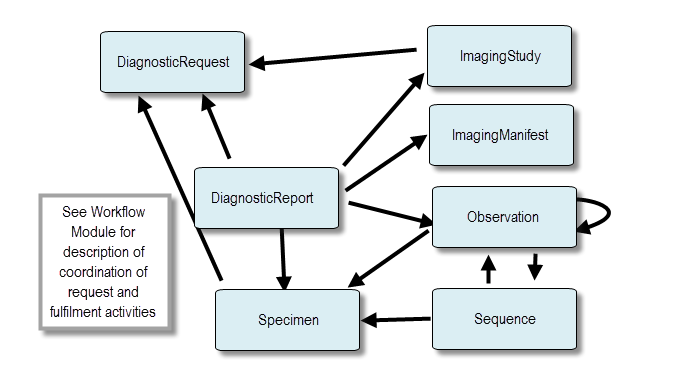This page is part of the FHIR Specification (v1.8.0: STU 3 Draft). The current version which supercedes this version is 5.0.0. For a full list of available versions, see the Directory of published versions  . Page versions: R5 R4B R4 R3
. Page versions: R5 R4B R4 R3
Work Group Orders and Observations  Public Health and Emergency Response Public Health and Emergency Response  | Ballot Status: n/a |
The Diagnostics Module provides an overview and guide to the FHIR content that addresses ordering and reporting of clinical diagnostics including laboratory testing, imaging and genomics.
The Diagnostics module covers the following resources:
The diagnostic resources and their relationships are shown below. The Arrows represent the direction of the references between resources. For example, DiagnosticReport references DiagnosticRequest.

Note: See the Genomics Implementation Guidance for additional information about how to use the Diagnostic resources for Clinical Genomic Reporting and Analysis.
| Name | Aliases | Description |
| Observation | Vital Signs, Measurement, Results | Measurements and simple assertions made about a patient, device or other subject. |
| DiagnosticReport | Report, Test, Result, Results, Labs | The findings and interpretation of diagnostic tests performed on patients, groups of patients, devices, and locations, and/or specimens derived from these. The report includes clinical context such as requesting and provider information, and some mix of atomic results, images, textual and coded interpretations, and formatted representation of diagnostic reports. |
| DiagnosticRequest | A record of a request for a diagnostic investigation service to be performed. | |
| ImagingStudy | Representation of the content produced in a DICOM imaging study. A study comprises a set of series, each of which includes a set of Service-Object Pair Instances (SOP Instances - images or other data) acquired or produced in a common context. A series is of only one modality (e.g. X-ray, CT, MR, ultrasound), but a study may have multiple series of different modalities. | |
| ImagingManifest | Manifest, XDS-I summary, Key Images | A manifest of a set of DICOM Service-Object Pair Instances (SOP Instances). The referenced SOP Instances (images or other content) are for a single patient, and may be from one or more studies. The referenced SOP Instances may have been selected for a purpose, such as conference, or consult. Reflecting a range of sharing purposes, typical ImagingManifest resources may include all SOP Instances in a study (perhaps for sharing through a Health Information Exchange); key images from multiple studies (for reference by a referring or treating physician); both a multi-frame ultrasound instance ("cine" video clip) and a set of measurements taken from that instance (for inclusion in a teaching file); and so on. |
| Sequence | Raw data describing a biological sequence. | |
| Specimen | A sample to be used for analysis. | |
| BodySite | anatomical location | Record details about the anatomical location of a specimen or body part. This resource may be used when a coded concept does not provide the necessary detail needed for the use case. |
The diagnostic resources often represent patient-related data, and as such are susceptible to data breaching. Necessary privacy and security provision must be in place for searching and fetching this information. For more general considerations, see the Security and Privacy module.
Diagnostic resources are commonly used as to order and report clinical diagnostics:
There are many ways to use these resources independently as well. The Observation resource in particular is central to capturing many measurements and events in healthcare and is often used outside the context of diagnostic orders and reports.
Observation and Diagnostic Report resources have been tested and used in production tooling and as such have reached a maturity level (FMM) where changes become less likely.ImagingStudy resource has had some limited testing and use. Further use of this resource in production tooling in order for it to reach a more stable FMM level.These other diagnostic resources are still under development:
DiagnosticRequest: used in the HL7 production tooling and in several implementation guides. As a result of the addition of FHIR workflow for STU3, the DiagnosticRequest resources has undergone substantial changes since DSTU2. It has been renamed from DiagnosticOrder and its structure and content updated to align with a general "request" pattern. Because of this, it remains an immature resource.Specimen: We expect to see more widespread use of this resource and future updates to its FMM levelImagingManifest: We expect to see more widespread use of this resource and future updates to its FMM levelSequence: This resource remains draft and we expect to see more widespread use of this resource and future updates to its FMM levelBodySite: This resource remains draft and its whether it remains a FHIR core resource is still uncertain. It can only be referenced using extensions.